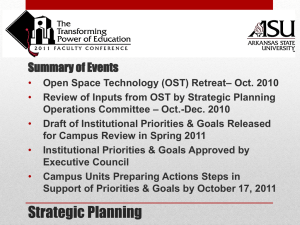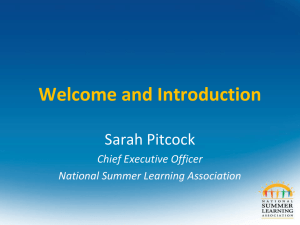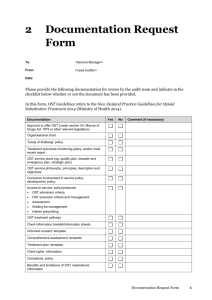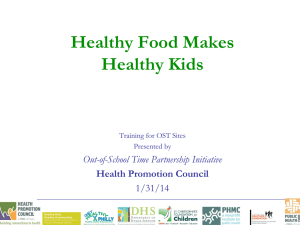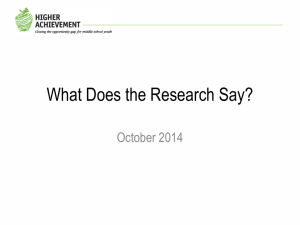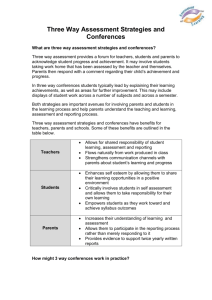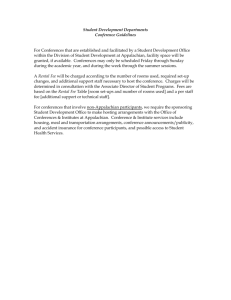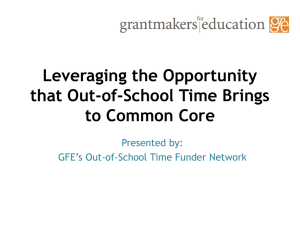An In-Service Professional Development Tool
advertisement
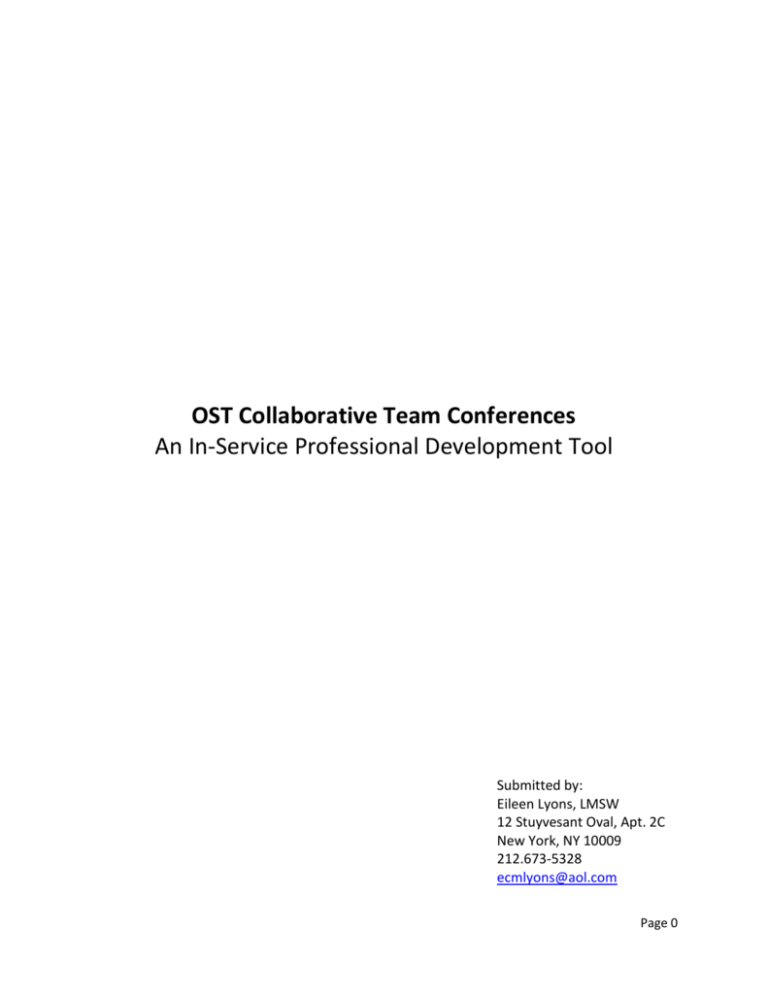
OST Collaborative Team Conferences An In-Service Professional Development Tool Submitted by: Eileen Lyons, LMSW 12 Stuyvesant Oval, Apt. 2C New York, NY 10009 212.673-5328 ecmlyons@aol.com Page 0 Introduction Few out-of-school time (OST) programs conduct team conferences or formal, focused discussions in which staff members reflect on how young people are succeeding in their programs. Staff members talk about program participants all the time, but those conversations are typically informal, taking place around the water cooler, for example, or at the end of the work day and even during shared commutes on the subway or bus ride home. When a child merits a sit-down staff meeting, he or she is likely in trouble or at risk of being expelled from the program. The benefits of child-focused team conferences to OST programs have yet to be established. Few OST practitioners have participated in or facilitated such conferences, and shoe-string budgets provide little latitude for the time needed to do so. This article explores the collaborative team conference (C-Lab), an in-service professional development practice, in an out-of-school time setting and its role in program quality improvement. The C-Lab is a structured team conference in which staff members reflect on a child’s program progress, share observations of and experiences working with the child, and collaboratively develop a strategy for fostering the child’s development and growth. Two conference tools focus discussion, enabling staff members to reflect on and think deeply about the child and create strategies for fostering his or her healthy development. Research examines the impact of C-Labs on practitioners’ work with children in an OST setting. Page 1 Youth Workers Play the Pivotal Role in OST Programs. The success of achieving positive youth outcomes rests on the shoulders of every youth practitioner. They are responsible for engaging and building caring relationships with young people, facilitating their positive peer connections, and creating a safe, supportive environment with engaging activities. Studies show connections between the quality of staff and the quality of the youth development setting as well as positive youth outcomes (Eccles & Gootman, 2002; Hall & Gannett, 2010; Little, Wimer & Weiss, 2008; McLaughlin, 2000; Tolman, Pitmann, Yohalem, Thomases & Trammel, 2002;) Findings from the Massachusetts Afterschool Research Study indicated that: “Programs with more highly educated and trained staff, both program directors and direct service workers, demonstrated high quality staff engagement, youth engagement, activities and homework time” (Miller, B., & Hall, G., 2007). Conversely, Smith, Peck, Blazevski, Akiva & Denault, note that in more than 50% of the after school programs they studied, staff’s limited ability to foster children’s motivation and deeper cognitive engagement through programming resulted in OST programs that resemble child care models rather than youth development settings. The ‘caring relationship’ between youth and staff, an essential feature of youth development settings (National Research Council and Institute of Medicine, 2002), is at the heart of effective youth work. Studies show that strong positive relationships with adult staff keep youth coming back to programs (Russell, Mielke and Reisner, 2008) and stand as an essential factor in achieving positive youth outcomes (Bart, 2005; Roth and Brooks-Gunn, 2000). Page 2 The youth worker is the central medium for translating and implementing youth work -a practice that is complex. It requires continuous, nuanced and well-judged responses in a variety of contexts and situations (Wilson-Ahlstrom, A., Yohalem, N., and Pittman, K., 2008, Larson and Walker, 2010). Larson and Walker (2010) note, as research increasingly highlights the essential role of the youth worker, it is essential to understand the “practices and processes” of the youth worker. Unlike basic safety practices which can be legislated, the dynamics that youth workers encounter are ambiguous, holding few cut and dry answers. In the absence of a practice framework, youth workers may draw on their own experiences – with variable outcomes. In the absence of reflection and in-depth thinking, youth workers may practice in superficial ways, avoid uncomfortable dilemmas, and fail to plumb opportunities that could yield benefits to youth. Researchers are calling for professional development that fosters more critical thinking, self-awareness and intentional practice (Hirsch, 2005; Larson & Walker, 2010; Smith, 2006). Larson & Walker (2010) argue that “To create and sustain high quality youth development programs it is important to understand the challenging situations and dilemmas that emerge in program leaders’ daily work with youth.” Page 3 When examining the youth worker role, we encounter inconsistencies in role definition. We ask OST staff to develop caring, authentic and meaningful relationships with youth, but do not provide the support they need to follow through. Youth share countless realities with OST staff -- from their excitement about an excellent test score to family crises, personal drug use and thoughts of suicide. How OST staff respond to these pieces of information is one matter; whether staff are sufficiently trained to handle these situations is yet another. The OST workforce is young, relatively inexperienced, part-time and transitory (PASE, 2008). Many staffers reside in the neighborhoods in which programs are located, are demographically similar to the youth they serve, and participated in after school programs as children. Their part-time positions are limited in duration. Wellspring for TASC (2006) examined staffing in 150 school-based after school programs, reporting that 44% of the workers surveyed were either college or high school students, (35% and 9% respectively). The composition of its work force holds implications for the structure of OST professional development; it may also, in part, define (and limit) the youth worker’s role. Page 4 Professional development in the OST field is a hybrid – a microcosm of the field itself. Since its inception, the OST field has debated its own identity, vacillating between education, a field from which it had originally hoped to distinguish itself – and youth development, social group work, recreation and other professions. OST professional development continues to draw on these professions, a factor that enriches its perspectives immeasurably. The field, however, has yet to develop a distinctive practice framework that integrates and synthesizes these professional strands. A glance at the professional development trainings provided by New York City’s Department of Youth and Community Development (DYCD, Winter, 2012) – illustrates offerings from mental health, education, social work, recreation, and youth development. The Features of High Quality Professional Development In a literature review on the effects of professional development on program quality and youth outcomes, Hill (2012) notes, there is no research that empirically links professional development to improved youth outcomes. Rather than dismiss the value of professional development, Hill suggests that we conduct research that may establish connections, and, act on a leap of faith, by fostering high-quality professional development –the characteristics of which research has identified. Garet, Porter, Desimon, Birman, and Yoon (2001), in a study that examined outcomes of the Eisenhower Professional Development Program for teachers, identified features associated with high quality professional development including duration, time span, coherence, collective participation and professional communication among practitioners. Their findings indicated that “…sustained and intensive professional development is more likely to have an impact … Page 5 than is shorter professional development,” and when it is grounded in the realities of the school day. Hill, (2012) notes that research-based consensus underscores several characteristics associated with high quality professional development: “It is sustained over a period of time, coherent, content focused, and based in a community of learners.” (2012) The National Staff Development Council (NSDC) averred, stating that high quality professional development in education: “addresses student-learning needs; incorporates hands-on technology use; is jobembedded; has application to specific curricula; addresses knowledge, skills, and beliefs; occurs over time; and occurs with colleagues.” When content is embedded in practice, and practitioners are supported to integrate new learning into their daily practices, coherence is promoted (Penuel, Fishman, Yamaguchi, and Gallagher (2007). The provision of “sustained, in-depth professional development rather than ‘one-shot’ workshops” is underscored by Chung Wei, Darling-Hammond, & Adamson (2009) who note that professional development of greater duration over longer periods of time with a single focus is key to high quality. Looking to the future, PASE (2008) suggests that “To the extent possible, professional development should be offered on site and the internal capacity of agencies to train their own staff, including in the areas of supervision and coaching, should be developed at the site level as well.” By equipping staff with a theoretical framework, principles of learning can be sustained and applied to a variety of situations. Chung et al (2009) emphasize that professional development should enable participants to grasp the theory that undergirds practice. In so Page 6 doing, they acquire guiding axiom that enable them to apply the learning in a variety of contexts. They state “Because beliefs filter knowledge and guide behavior, professional development must address teachers' beliefs, experiences, and habits.” Walker and Larson (2010) note that as the importance of the youth worker’s relationships with youth is discerned, the complexities of the skills sets required are highlighted. They contend that in order for youth workers to consider multiple factors in their work -- including ethics, organization and interpersonal -- they need professional development that enhances their capacity for reflective practice. Collaborative Team Conferences in Out-of-School Time Settings Team conferences are common in many professions ranging from medical grand rounds to social work case conferences. They are guided by varying purposes. Bringing together staff members who have essential information about the patient or student is efficient. It enables practitioners to exchange information and discuss problems and next steps. At Good Shepherd Services (2007), staff participate in (monthly), 6-7 minute mini-conferences in which teachers and social workers share essential, new information, make decisions and determine next steps. The ‘descriptive review of a child’ developed by Carini (2011) evokes the C-Lab; it is a constructed conversation that assists educators to “know” a child in order to better meet his or her educational, social and physical needs. Kelly (2012) provides a working modification based on Carini’s protocol, maintaining that practitioners’ non-judgmental stance is essential, and that reviews are most powerful when conducted in a professional learning community. Armistead’s Kid-Talk (2004), which adapted the descriptive review protocol, asks teacher-participants to follow these guidelines: “try to make observations clear and objective, Page 7 withhold judgments and assumptions, and make recommendations that improve instruction.” Armistead reports that as a result of their structured conversations, teachers noticed positive changes in students. Teachers reported that they paid more attention to their students’ needs and, rather than referring out students (e.g., to the social worker) for problems, they began to institute classroom-based solutions. Collaborative Team Conferences are Aligned with OST Programs As a professional development tool, the C-Lab is designed to foster effective, studentcentered practices in out–of-school time settings. Its highly structured protocol and two practice tools enable staff to translate their direct experiences with children into essential insights to the child’s developmental, social and academic needs. The C-Lab design is aligned with the realities of the youth work field. By valuing equally members’ observations, it levels the playing field on teams where members show substantive differences in their work experience and credentials. The C-Lab is designed with the idea that many youth workers are intuitively gifted in their practice but lack the rigor associated with advanced education and supervised practicum, in particular, to articulate just what it is they do and why. These staffers may register children’s needs -- and respond correspondingly, many times appropriately as not -- but lack the explicit intentionality that would make a positive difference in their practices. C-Lab discussions are imbedded in the program. Participants are helped to make explicit their reasoning or intuition. They engage in trial and error processes in order to see what works best. Youth workers reflect on their practice and its effectiveness in the field. For example, the practitioner working with early adolescents who must frequently remind students of Page 8 consequences and the importance of decision-making may fail to recognize the developmental principles at play. Instead, the practitioner may simply feel ‘like a nag’. Staff members may consciousness and intentionality in their work. C-Labs assist youth workers to examine their emotional reactions to children. The question: “What emotion/s does this child evoke in you?” enables staff to tune into behaviors that push their buttons. The purpose of C-Labs is to understand the young person in order to assist him or her to succeed. Other objectives are realized as a result of group process and content. Team members get on the same page as they compare notes and coordinate their efforts. The team acquires a shared sense of purpose as members exchange feedback and support. A learning community is constructed in which perspectives and disciplines are represented; a common language is created. While the mission and values of the program/organization are referenced, the integrity of program rules and policies are tested in real time. Some conference revelations may highlight organizational discrepancies, team inconsistencies, or lapses in program services; others may provide data for future program planning, budgeting or policy-making. Discerning inconsistencies between program design/curriculum and student need is not the intended purpose of team conferences, but it is not an unexpected consequence. In one NYC high school, a widespread academic problem came to light as a result of several conferences. Staff identified ‘problem’ students as severely delayed readers; the school did not, up to that point, offer reading remediation or specific accommodations in class. Page 9 Collaborative Team Conference Tools C-Labs employ two different tools: the ‘framework,’ assists practitioners to draw on their observations of and experiences with children. That information is used as program data. The ‘planning tool’ guides practitioners to reflect on their observations in order to identify the theories and beliefs that shape their thinking and to build specific strategies for working effectively with children. Both tools help practitioners to translate their intuition into explicit language and, ultimately, intentional practice. The framework focuses on children’s functioning in several domains -- social, physical, academic, cognitive and developmental. With input from staff members, frameworks are customized for every setting. The C-Lab assumes that: a complete family, school and/or personal history may not be known to staff; all questions cannot and need not be answered by any one staff person; and participants will contribute differently to the process. The framework itself draws on developmental, social work and education theories and principles. The focus on relationships as well as safety, high expectations, mastery, voice and other features of positive youth development -- is especially relevant to out-of-school time programs. A sample framework can be viewed in Box 1. Page 10 BIO; PROGRAM FACTS SCHOOL STATUS NATURE OF CONNECTION TO COMMUNITY (ENGAGEMENT) Gender____D.O.B._______Age:_____ Born in_________________________ Date Emigrated__________________ Family Composition_______________ _______________________________ Primary Language Spoken__________ # Years in program________________ □ attendance is regular □ attendance is not regular Explain: ________________________ Current School__________________ Grade/Class____________________ Teacher________________________ School HX_______________________ Young person’s role in program ________________________________ Any special needs_________________ _______________________________ (If yes, explain) ___________________ _______________________________ Family situation affecting y.p.? _______________________________ _______________________________ Are y.p.’s reading and math skills on target__________________________ _______________________________ What y.p. wants or needs from FYI___ _______________________________ _______________________________ Do we have a relationship with young person’s teacher or principal? Any Comments_____________________ ______________________________ LEARNING/ENGAGEMENT IN ACTIVITIES □ Interrupted Education □ Currently attends ELL Class No. Years in ELL Class____________ □ Receives Special Services _________ INTERESTS, SKILLS & ASSETS How much and to what degree is y. p. engaged in program?______________ _______________________________ Does student offer his/her ideas and individual thinking in the group? ___ ______________________________ How active/passive is young person, generally, (in activities, discussions, with peers, in groups)? ____________ _______________________________ How does y.p. follow directions? _______________________________ How does y.p. lead?______________ _______________________________ What motivates young person? _____ _______________________________ What kind of homework support does student need ___________________ Describe y.p.’s focus...ability to stay on task: ___________________________ _______________________________ What activities does student prefer? ______________________________ ______________________________ Young person appears most engaged when… ________________________ What special skills or assets does y.p. demonstrate? ___________________ _______________________________ How does y.p. handle conflict? _______________________________ _______________________________ What are y.p.’s interests outside of program? _______________________ _______________________________ What is the y.p.’s level of trust? _______________________________ How do we expand this y. p.’s horizons? _______________________ _______________________________ How does young person fit in socially? _______________________________ _______________________________ How is y.p. perceived by staff? ________________________________ ________________________________ How is y.p. perceived by peers? ________________________________ Is y.p. affected in any way by racism, bullying, violence, getting teased? ________________________________ ________________________________ What does y.p. evoke in you? ________________________________ ________________________________ Does y.p. rely on or have a support system? ________________________________ ________________________________ DEVELOPMENTAL; TRANSITIONS What kinds of transitions is the y.p. going through?___________________ ________________________________ ________________________________ Do you have any concerns or thoughts about y.p.’s health, hygiene, nutrition or clothing? _____________________ Does this y.p. practice healthy habits? ________________________________ Are you concerned about any safety issues concerning this y.p.? ________________________________ ________________________________ What expectations does this young person have for his/her future? _______________________________ _______________________________ The thing that stands out for me in working with this young person is… ________________________________ ________________________________ Page 11 The second tool, the planning sheet (Box 2) – assists practitioners to think deeply about the child with whom they are working. Aligned with Remer’s (2012) concept of authentic reflection, practitioners engage in a three-step process: (1) identify facts about the child (no hear-say or speculation); (2) indicate why it is important to understand each of those facts (underlying principles); and (3) choose next steps to steer team or individual actions and tasks. This process assists team members to: distinguish fact and observation from speculation; think more deeply about the beliefs and principles that drive their practice; and design a plan aligned with the young person’s needs. Page 12 Box 2. The Planning Sheet Team Planning Sheet Student’s Name: __________________________________ Today’s Date: _________________ Presented by: _____________________________________ Participants: __________________________________________________________________ Meeting Purpose/Reason: ________________________________________________________ (THE FACTS) It is important to understand that (this child)… (WHAT WE MIGHT INFER) It is important to understand this because… Therefore, the team/I need to… 1.___________________________________________________________________________________ 2. ___________________________________________________________________________________ 3.___________________________________________________________________________________ 4.___________________________________________________________________________________ Other________________________________________________________________________________ _____________________________________________________________________________________ Page 13 Research Design: a mixed methods approach -- including a pre- and post-test questionnaire, observation and a focus group -- was employed to determine the impact of collaborative team conferences (C-Labs) on staff knowledge, attitudes, and skills -- including problem-solving, youth engagement, and limit-setting. The author facilitated ten (10) two-hour C-Labs, over the course of three and a half months at a community-based agency in New York City that serves children and teens, ages 8 – 18 years old. The mission of the organization is to support and encourage the efforts of young people to design and carry out community service projects, develop leadership skills, fulfill their potential, and realize their dreams. Nine group participants consisted of five (5) women and four (4) men with varying educational credentials ranging from high school diplomas to graduate degrees; six members of the group were Latin, two African-American, and one Caucasian. Two participants exited the agency around the time of the 8th conference. The pre- and post-questionnaire, developed for the purposes of this research, consisted of 49 scaled questions and 3 open-ended questions derived from existing youth development evaluation tools including1. The facilitator guided the group through consecutive stages of development. During the first session, ground rules, including confidentiality were discussed. The facilitator asked team members to modify the ‘framework’ tool so that it reflected their program’s goals and objectives. Team members were introduced to the process and ‘tools’, as well as their roles and 1 Tools used include: the PASE Afterschool Youth Outcomes Inventory (2010); NYSAN Program Quality SelfAssessment Tool; the Policy Studies Associates, Out-of- School Time Observation Instrument (2008); and the National School Climate Center, Comprehensive School Climate Inventory; the Social and Emotional Learning (SEL) Standards and Benchmarks for the Anchorage School District Page 14 group expectations, and then immediately participated in a conference, learning the process by doing. Conferences adhered to the following protocol: 1. At the start of the conference, the team identifies the children/teens to be discussed and in what order. The team determines a preliminary purpose for conferencing each child and refines it over time. 2. A lead presenter (‘the lead’) for each child is identified. 3. A blank ‘framework’ (Box 1) is distributed. 4. Keeping the young person in mind, team participants independently read through the framework questions -- writing their own thoughts and comments (about ten minutes). 5. The facilitator asks the lead to introduce the young person by sharing general information, and then review the remaining relevant points of the framework. Participants are reminded to share their observations and first-hand experiences, only. 6. Next, all team members are invited to share their observations of, insights to and knowledge of the student. Team members will likely share some similar and some different observations. 7. The floor is open for questions and discussion. 8. Team members individually complete planning sheet (Box 2). Individuals share their planning sheet ‘stems’ with the larger group. 9. A plan (next steps and/or strategy) is developed and documented using the planning sheet. Process and Content Observations: At the start, team members described themselves as a close-knit group; observations of the ways in which they communicated, handled differences, and shared humor suggested that they were an established team with positive group norms. The team also noted that they talked informally about participants every day at the end of the program – often at great length. Page 15 C-Lab discussions were lively; participants nearly always seemed highly engaged, despite the 6:30 to 9:00 p.m. meeting time. While there were ready volunteers to take the lead and ‘present’ a young person, participants expressed some anxiety about assuming that role. During the second conference, team members reported they had begun to think differently about program participants; the first conference evoked in them tremendous sympathy for the young person discussed during the prior week. The team elected, during each session, to discuss young people who were problematic (e.g., disrupted activities; bullied participants). Conference discussions revealed that these children were coping with serious family problems including poverty, homelessness and mental health problems as well as personal problems such as seriously delayed academic skills, peer group problems and difficulty controlling anger. Observations of staff interactions with (conferenced) participants during program time might be best described as warm, engaged, highly verbal, ‘family-like’, affectionate, tolerant of differing opinions, and respectful. During C-Labs, one staff member talked about some relationships as “draining”. Over time, participants noted they had begun to think in new ways about working with the conferenced children, and that they had also begun to transfer learning to relationships with other children. Participants demonstrated increasingly a capacity to create conference “purpose” statements that reflected nuanced reflection. The following ‘initial’ purpose statement: To discuss Javier because he’s a bit of an outcast; was modified to: To help Javier to figure out how he can belong. The latter statement shows the team members’ growing Page 16 appreciation for their role in the service of helping the young person meet his stated need – i.e., to ‘fit in’ and belong. During the course of conferences, practitioners reported on ‘difficult’ information that young people had shared with them e.g., “I live in a shelter.” “My mother doesn’t care about me so she left,” “My friends don’t like me anymore.” Staff members reported saying nothing or objecting to the legitimacy of the problem (e.g., “that’s not true” or “but I see you with your friends”). Team members were encouraged to acknowledge and normalize children’s feelings before assisting them to reality-test. Reflecting on children in the context of their developmental stage was emphasized. Discussions on developmental concerns, especially transitions ensued. Staff examined the pervasive struggles of adolescence that they observed – the push and pull of adolescence, and variable levels of maturity and childish behavior. With an increased focus on the “planning” tool, staff worked resolutely to provide positive opportunities for children. A baseball team is being revived for one child, a new “leaders’ group” was launched for several young men who were disrupting activities. Staff members noted that the conference tools helped them to think more deeply. One member likened the conferences to group therapy; she felt supported by the team. One member confided that s/he did not say much but that s/he was “listening to everything.” At the last conference, a participant asked “what will we do now when we have a problem?” Focus Group: One, one-hour focus group was conducted. The focus group interviewer noted that “the ‘formality’ of the C-labs imprinted on staff members’ practices a new sense of purposefulness.” One C-Lab participant reported that the C-Labs provided a “wake-up call” – an epiphany alerting her to the need to better know the young people with whom she works. Staff Page 17 were surprised to realize that despite their strong, caring connections with youth, they did not really know them. Now they find themselves wanting a great deal more information about each child. Staff reported specific changes in their own behaviors. One staff member stated that when he now sits at the front desk to sign-in young people, he takes time to check-in with each of them every day. He and others reported that they ask young people specific, targeted questions about home and school as a result of the C-Labs. They also agreed that they take more time to reflect on the participants whom they do not know, and that they employ learning principles from prior conferences. By getting to better know participants, staff reported gaining more insight. Staff avowed to monitor carefully the intake process and flow of student information. Members reported feeling ‘embarrassed’ when they realized how little factual information they knew about their young people. Some staff felt unprepared to handle the problems and ‘difficult’ personal information that young people began to share. Questions about confidentiality emerged. Without a universal confidentiality clause – stating that all staff share concern for -- and therefore information about -- young people, some staffers find themselves overwhelmed, holding inordinate amounts of confidential information. Participants wanted more time to construct and discuss the ‘next step’ section, and to implement and evaluate the progress of next steps. When asked what they would want in the future, staff universally answered “more of everything.” Pre- and Post-Test Questionnaire: Because the sample was both small (N=7) and nonrandom and measurement was developed at the nominal level, differences between pre-test and postPage 18 test responses were identified by examining the number of changed responses between the two test times. An analysis of the differences showed some nominal trends. Specific differences included increases in staff’s perceptions of: the way children related to the worker; engaging youth by exploring their interests and thinking; asking more follow-up questions of young people; and observing children’s ability to participate in activity. One difference indicated a negative trend in response to the statement -- “I change my leadership/teaching strategy in response to a student’s learning style.” This may suggest that staff became more realistic or self-aware of their abilities. In their responses to three questions that presented anecdotal dilemmas, staff showed, overall, an increase in engaging young people by exploring problems before designing solutions. Discussion The nominal changes between responses to the pre- and post-questionnaire suggest that the major effects of the C-Labs were not captured in the measurement tool. The questionnaire was designed to measure youth development knowledge, beliefs and interventions. The baseline responses that staff offered in the pre-questionnaire suggested that most staff had mastered this preliminary material. As a professional development tool, the C-Lab is distinctive because it brings together staff members from different disciplines, with varying levels of education and experience, and exhorts their critical thinking and reflection. The C-Lab can potentially be one of many OST routines and traditions around which common language and practices can be developed and transmitted. Page 19 Bolstering the conference structure in order to advance rigorous reflection is essential. Insights gleaned from the research, recommend equipping staff with increased knowledge prior to start-up and, providing prompts to assist staff in planning next steps. A preliminary, comprehensive training should focus on child/adolescent development including stages and related tasks, cognition, educational needs and learning styles. (As one aspect of this training, participants could design their program’s conference framework.) The planning tool should be supplemented with a user-friendly prompt sheet that lists multiple practices, interventions and steps that the team/practitioners can take in order to advance the young person’s program success. It is essential to open lines of communication with management to assure that program problems and unmet are translated. Finally, to more widely implement the C-Lab, agency-based conference facilitators will need to be trained. The C-Lab warrants continued research. The benefits of the C-Lab as an OST professional learning communities should be explored. Research can clarify the province of the youth worker. Measures that capture changes in critical thinking, reflection, intentional practice, transfer of learning, and problem-solving need to be developed. The impact of the CLab on youth outcomes deserves attention. We need to better understand how to respond to children’s cognition, communication and learning styles in OST programs. A cost/benefit analysis could help to procure funding and support. Future research may also seek to understand how the OST youth worker can confidently draw on positive youth development to support the child who faces overwhelming personal Page 20 odds. The C-Lab was designed to reflect on immediate relationships and activities during OST time. Despite that effort, staff’s focus quickly extended to children’s problems outside of OST, thereby opening a proverbial can of worms. If we are to stay alert to children’s pain, it will necessitate sustained professional development, compensation for staff time, and greater numbers of full-time staff. Following the 12/14 tragedy in Newtown, CT, this very issue came to the fore. A revived focus on severely troubled youth repeats the mantra – “relationships, relationships, relationships” – suggesting that the power of relationships to nurture, protect and encourage young people will always trump a show of security at the gates. Indeed, that relational focus benefits all children and young people – not just the severely disturbed. There is a clarion call for the community of people who work with youth to know them, truly know them. And then what? Legislators and policy-makers must allocate sufficient support to mental health and social services so that those needs are better met. It is not either mental health or OST. It is both. Policy-makers must put in place the resources, professional development and funding that providers require -- as part and parcel of the public mandate we have received -- to care for our children. Page 21 WORKS CITED Armistead, R., Chajet, L. KidTalk: A strategy for building common understanding about students. In Focus, Vol. 1, #2, 2004. The Youth Development Institute, Fund for the City of New York. Chung Wei, R., Darling-Hammond, L., Andree, A., Richardson, N., & Orphanos, S. (2009). Professional learning in the learning professional: A status report on teacher development in the United States and abroad. Dallas, TX: National Staff Development Council. Eccles, J. S., & Gootman, J. A. (Eds.). (2002). Community programs to promote youth development. Washington, DC: National Academy Press. Garet, M. S., Porter, A. C., Desimone, L., Birman, B. B., & Yoon, K. S. (2001). What makes professional development effective? Results from a national sample of teachers. American Educational Research Journal, 38(4), 915-945. Good Shepherd Services, (2007). South Brooklyn Community High School: A Model Transfer School for Replication. Retrieved from http://www.goodshepherds.org/images/content/1/1/11027.pdf Hall, G., & Gannett, E. (2010) Body and Soul. Reflections on two professional development credential pilots in Massachusetts. Afterschool Matters, 10, 13 – 21. Hill, Sara. (2012) Leap of Faith: A Literature Review on the Effects of Professional Development on Program Quality and Youth Outcomes. National Institute on Out-of-School Time, Wellesley, 2012. Hirsch, B., (2005). A place to call home: After-school programs for urban youth. American Psychological Association: Washington, D. C., and Teacher’s College Press: New York. Kelly, K., (2012). The Descriptive Review of a Child, National School Reform Faculty. Retrieved from http://www.nsrfharmony.org Larson, R., & Walker, K. Dilemmas of Practice: Challenges to program quality encountered b youth program leaders. American Journal of Community Psychology, (2010) 45:338–349. Little, P. M.D., Wimer, C., & Weiss, H.B. (2008, February). After school programs in the 21st Century: Their potential and what it takes to achieve it. Issues and Opportunities in Out-ofSchool Time Evaluation Brief No. 10. Cambridge, MA, Harvard Family Research Project. McLaughlin, M. W. (2000). Community counts: How youth organizations matter for youth development. Washington, DC: Public Education Network. Page 22 Miller, B., & Hall, G. (2007). What counts in after school? Findings from the Massachusetts Afterschool Research Study (MARS). Journal of Youth Development, 55(3), Article No. 0603RS001. New York State After School Network (NYSAN). NYSAN Program Quality Self-Assessment Tool. Retrieved from http://www.nysan.org/section/quality/qsa National School Climate Center. Comprehensive School Climate Inventory. Retrieved from http://www.schoolclimate.org/guidelines/schoolclimateimprovement.php National Research Council and Institute of Medicine, (2002). Community Programs to Promote Youth Development. Washington, DC, National Academy Press. National Staff Development Council. Review of the Research: Nine Components of Effective Professional Development. Prepared for Texas Instruments Educational and Productivity Solutions Division by the Institute for the Advancement of Research in Education at AEL April 2004 Partnership for After School Education. Voices of After School: Facts from the Field, New York, 2008. Retrieved from http://www.pasesetter.com/publicationResources/Publications/PDF/2009%20Afterschool% 20Workforce.pdf Partnership for After School Education. PASE Afterschool Youth Outcomes Inventory, 2010. Retrieved from http://www.pasesetter.com/outcomes/outcomes_inventory.html Penuel, W. R., Fishman, B. J., Yamaguchi, R., & Gallagher, L. (2007). What makes professional development effective? Strategies that foster curriculum implementation. American Educational Research Journal, 44(4), 921–959. Policy Studies Associates, Out-of- School Time Observation Instrument, 2008. Remer, Abby, (2012). Retrieved from http://www.virtualforum.com/aremer/authenticreflection topic.cfm Roth, J., and Brooks-Gunn, J. What do Adolescents Need for Healthy Development? Implications for Youth Policy. Social Policy Report, 2000, 14(2). Russell, C., Mielke M., and Reisner, E., Evaluation of the New York City Department of Youth and Community Development Out-of-School Time Programs for Youth Initiative: Results of Efforts to Increase Program Quality and Scale in Year 2. Policy Studies Associates, Inc. New York, NY: New York City Department of Youth and Community Development, 2008. 1-14. Page 23 Smith, C., Peck, S., Blazevski, J., Akiva, T.,& K Denault, A. (2006). Quality at the point of service: profiles of practice in after-school settings. New Directions for Youth Development, Vol. 2006, No. 112, pp.93-108. Social and Emotional Learning (SEL) Standards and Benchmarks for the Anchorage School District. Retrieved from http://www.asdk12.org/depts/SEL/media/SEL_Standards.pdf Smith, C., Peck, S., Blazevski, J., Akiva, T. & Denault, A. Quality at the point of service: Profiles of practice in after-school settings. American Journal of Community Psychology. June 2010, Volume 45, Issue 3-4, pp 358-369. Strieb, L., with Carini, P., Kanevsky, R., Wice, B., The Art of Teaching, and The Classroom and School, Revised Edition, Prospect Center, Winter 2011, The Prospect Archives and Center for Education and Research, North Bennington, VT TASC Annual Report 2007-2008. TASC -- The After-School Corporation. 1-17. Tolman, J., Pittman, K., Yohalem, N., Thomases, J., & Trammel, M. (2002). Moving an out-ofschool agenda: Lessons across cities. Takoma Park, MD: Forum for Youth Investment. Wilson-Ahlstrom, A., Yohalem, N., and Pittman, K. (2008). Unpacking Youth Work Practice. The Forum for Youth Investment, June. Page 24

